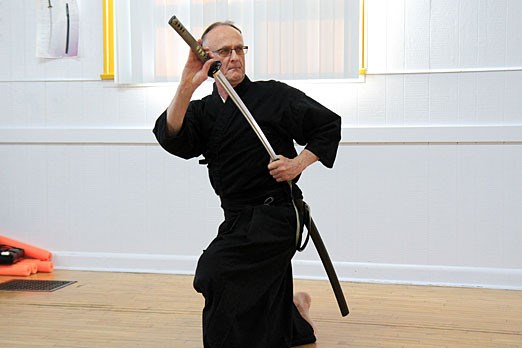Years of training boiled down to a single six-minute test for Iaido master Doug Martin.
Martin stood in front of a panel six and seven dan masters as he performed his series of katas or sequenced movements with his katana. Every move had to be accurate and precise in order for him to advance to the next level. Six minutes was all the time he had to accomplish the five katas.
He says it’s a lot of pressure.
“Compared to other martial arts, the test is actually short,” Martin says.
“Iaido is very much on the formalities and that is part of the testing. They do time you and it can be at the maximum six minutes. It is a lot of pressure to train for four or five years and then have it come down to a six-minute test.”
Martin did pass his test and advanced to become a fifth dan in the martial art. He spent 15 years training to reach that goal. He also is a sixth dan in Karate.
Iaido hasn’t been practiced as long as many other Japanese martial arts in Canada. Kendo for example has been here in Canada since the early 1900s.
He says the purpose of the Iaido, the art of drawing the sword, is to perfect movement. With every strike of the blade, the movement has to be perfect. He says the main goal of his training isn’t to get a higher grade but simply to improve himself.
“It isn’t complicated in a sense but it is very demanding,” he said.
Breathing is a big part of performing the kata correctly. He says the secret is breathing naturally.
“As we’re learning we try to learn how to breathe in and breathe out at different times. Usually when you try something you tense up and your breathing tenses up.”
Martin is a member of the Thunder Bay Rai Un Kai Dojo. There’s only a handful of members because it is a solo martial art and doesn’t require a partner to practice.
He says he’s never had problems traveling with his swords or weapons because he usually gives the airport a heads up. He’s even flown to Japan with a sword although it wasn’t a sharp one.
Story continues after video ...
While Iaido isn’t the only Japanese martial art in Thunder Bay, it is the only one dealing exclusively with a sword. But martial arts aren’t the only Japanese culture that’s here.
Steve Seller, president of the Lakehead Japanese Culture Association, says they have been quiet for the past 15 years since the organization started, but have recently begun to start making a bigger presence in the city.
The traditional Japanese dancers performed at the Folklore Festival last year and this year a group of local drummers will perform a show.
Seller says they have many artists in their organization who do traditional Japanese activities such as mizuhiki that is the art of tying silken cord.
He says sometimes it can be difficult to get that message out that Japanese culture is more than just martial arts.
“With Thunder Bay being such a small community Japanese culture wise it is hard to find expertise in these different fields,” Seller said. “We’re lucky to have a woman in Thunder Bay who can teach locals and then they are carrying that on. In terms of the drummer, we’re importing instructors from Winnipeg.”
He says the organization kept a low profile because there wasn’t that many members yet to volunteer to work these kinds of events.
He says they are actively trying to get more members to come and help.
According to Statistics Canada, Thunder Bay’s Japanese population is relatively small. There’s an estimated 500 Japanese Canadian’s living in Northwestern Ontario. Seller says very few Japanese people immigrate to Thunder Bay with maybe one every 10 years deciding to settle down.
“What we see more frequency in are visiting professors or spouses of professors,” he says. “We’re here we’re just not as visible as perhaps we should be.”
Anyone wanting more information about the Japanese Culture Association can visit the website.
